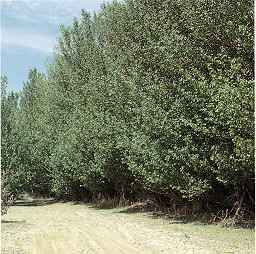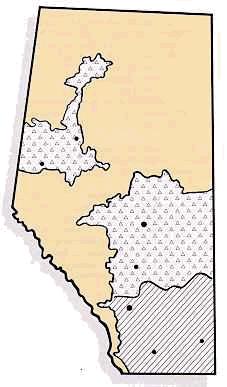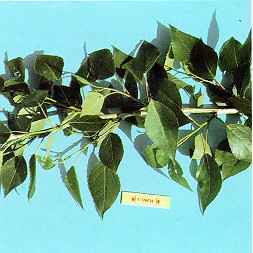| | Plant characteristics | Fall colour | Site preference | Hardiness | Uses | Problems | Diseases | Insects | Pruning
.

Scientific Name: Populus x 'Griffin'.
Plant Characteristics
This male hybrid poplar originated from a presumed cross between a female plains cottonwood and a male Russian poplar (Populus deltoides x Populus x petrowskyana) named by Mr. A. Griffin, superintendent of the C.P.R.'s Engineering Division at Brooks, Alberta 1955.
The sharply uprising branches on the central stem (narrow pyramidal form) are the main characteristics of this tree. The tree has a rather narrow crown. It is considerably shorter than other poplars. When mature it should reach a height of 6 to 15 m (20 to 50 ft) with a spread of 3 m (10 ft). This tree has an annual growth rate of 30 to 150 cm (1 to 5 ft). It has a useful lifespan of 10 to 20 years. The sharply uprising branches give the tree a similar appearance to the Lombardy poplar.
Bark - Carnation green.
Buds - Spanish orange, sticky.
Leaves - Leaves are alternate, simple, rhombic to obovate, serrate margin, glabrous, usually one gland, 2.5 cm (1 in.) wide and 2.5 to 5 cm (1 to 2 in.) long. They are the smallest of all the shelterbelt poplars.
Propagated by cuttings.
Fall Colour
Leaves - golden yellow.
Site Preference
Wide soil adaptation. Requires generous amounts of water, but will survive to short periods of low moisture. Can be planted in full sun or half shade.
Hardiness
Winter hardy to Peace River area but prone to frost-cracking.
.


Uses
Through its compact, upright growth habit, this poplar is very suitable for shelterbelt plantings where space is limited e.g. nurseries, irrigation farms with limited acreages.
In shelterbelt situations, it should be planted 2 to 4 m (6 to 13 ft) between trees in the row, and 5 to 8 m (17 to 26 ft) between rows.
Problems
This tree is weak-rooted. It requires moisture and therefore is not useful in dry or non-irrigatable areas.
Diseases
Highly susceptible to infections of canker.
Insects
Highly susceptible to infestations of borers. It is resistant to galls.
Pruning
The bottom branches of this tree should never be removed, since this practice spoils the appearance and windbreak effectiveness as well as promotes infection.
.

Shelterbelts Varieties for Alberta provides information on a number of other trees and shrubs than may be suitable for shelterbelts.
Visit our website directory for the Reforestation Woodlot Listings |
|